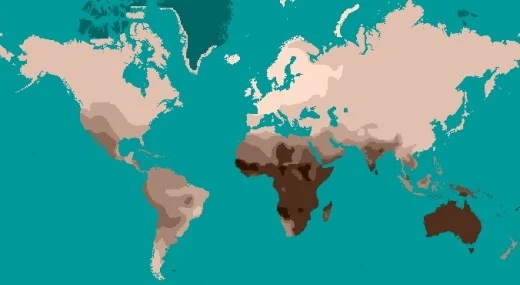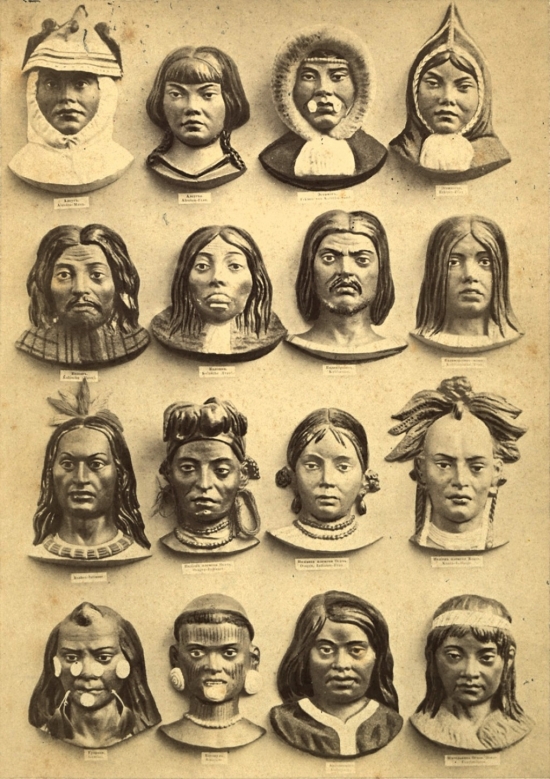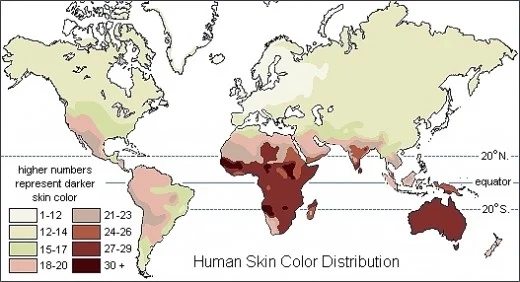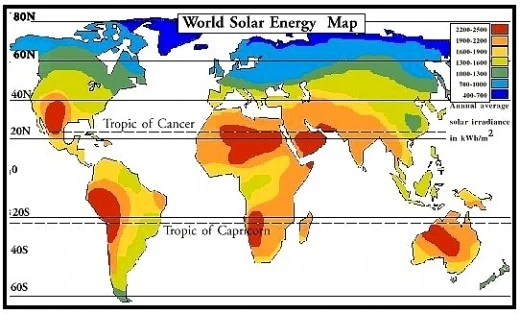Did Skin Color Evolve as an Adaptation to Sunlight Intensity?
Human skin color is highly variable around the world. Recent research has suggested that skin color developed as an adaptation to cope with the damaging effects of sunlight.
However the huge migration of human skin colour groups around the globe in the last 500 years has led to problems with vitamin D deficiency causing rickets and osteoporosis, and to folate deficiencies causing birth defects and reproduction problems.
Various skin color groups are no longer living in the areas that their skins were adapted to. This combined with the trend for people to stay indoors, use sunscreens and get less sun exposure has meant that various skin colour groups have to take various actions to reduce the risks of health problems arising from sun exposure and their skin color.






Human skin color ranges from a very dark brown among some Australians, Africans and Melanesians to a almost yellowish pink for some Northern Europeans. Skin tones of various groups of people tend to be color blends rather than true black, yellow, white or red, and these commonly used terms for skin color are generally incorrect and misleading.
--------------------------------------------
Fact - What Determines Skin Color
Skin color is primarily determined by a pigment named melanin. Both light and dark skin people have this same pigment. However, there are two forms firstly - pheomelanin, which is yellow to red in color, and secondly eumelanin, which is black to dark brown in color. People with light skin produce more pheomelanin, while those with dark skin mostly produce more eumelanin.
Also, individuals differ in the size and number of melanin particles. These aspects tend to be more significant in determining skin color than the kinds of melanin produced. In lighter skin, color is also determined by red cells in blood flowing close to the skin.
---------------------------------------------
Tanning - A response to increased sun exposure
Skin tanning is more obvious with light skin people, but dark brown skin can also tan due to prolonged exposure to the sun. Sunlight stimulates the pituitary gland which then release MSH (melanocyte-stimulating hormone). This hormone passes through the bloodstream to the melanocytes, causing them to generate more melanin. Since the pituitary gland is tied into the optic nerve, (the nerve in your eyes that lets you sense light), wearing sunglasses makes you tan less. The tanning response is a strong indication that skin color is very important in humans who have developed ways of changing skin color in response to sun exposure. This strongly suggests that the more permanent skin colour variations throughout the world is similarly adaptive and was an inherited trait selected to provide an advantage to various skin tones in various parts of the globe with varying sunlight intensity.
Skin Color Distribution Around the World


Before the mass global migrations of people during the last 500 years, dark skin color was mostly concentrated in the southern hemisphere near the equator and light color progressively increased northwards away from the equator, as illustrated in the map. There is a strong correlation between skin color distribution and sunlight intensity.
Most of the dark pigmented people originally lived within 20 degrees of the equator. Most of the lighter pigmented people lived in the northern hemisphere north of the 20 degree latitude. Correlated with this distribution is the UV light strength which is highest at the equator where the sunshine is more intense. Conversely, populations in cold climates nearer to the poles commonly have light pigmentation. The relative intensity of solar radiation is largely responsible for this distribution pattern. There are some exceptions to this distribution. The Inuit people live close to the north pole and yet they have darker skin case. It appears that this may be related to their diet which has rich sources of vitamin D allowing them to have darker skin and get less of their vitamin D requirements from sunshine exposure.
Why and how have these skin colors patterns developed?
Neanderthals probably had light skin colors that were better adapted to the cold climate at the end of the last ice age. It is generally believed that the early modern humans that develop in Africa had black skin and migrated north and east to populated the rest of the world. Why did these human populations get lighter skin color as they moved north? The reasons appear to be related to evolution and natural selection in responses to changes in UV radiation and to the inheritance of genetic mutations. See more details about this later.
Why were black skins an advantage in early humans?
It is suggested that as early humans moved from the forests into the hot, open environments in Africa in search of food and water. On the open plains they faced a major challenge in keeping cool. The favorable adaptation was to increase in the number of sweat glands on the skin and to reduce the amount of body hair. With much less hair, perspiration could evaporate more easily and better cool the body. But this hair-less skin was a potential problem because it was exposed to the intense sunlight in the area near the equator. The adaptive response was to select for a skin that was permanently dark so as to protect against the damaging rays of the sun. While UV rays can cause skin cancer, such cancers develop after child bearing age and so are unlikely to be selective. Evolution and natural selection works on reproductive success, and so the adaptations much relate to other health effects (or perhaps appearance) improving the reproductive success of the darker skinned individuals.
At least six hypotheses have been proposed for skin darkening: (1) reducing sun damage to sweat glands and cutaneous blood vessels, (2) protection against skin cancer, (3) protection against overproduction of vitamin D, (4) camouflage, (5) better protection from microorganisms, and (6) protection to vital processes and essential molecules such folates in the blood that are associated with reproductive success. UV light is known to penetrate lighter skin and destroy folate molecules and this reduces reproductive success of both males and females.
Major Ways in which Skin Colour is Adaptive
The adaptive advantages of skin colour are related to:
- Protection from UV radiation - Nature has selected for people with darker skin in tropical latitudes, especially in non forested areas, where UV radiation from the sun is usually more intense. Melanin acts as a natural protective shield against the effects of UV radiation. The development of a tanning response shows the importance of the skin color in protecting against the effects of sun exposure.
- Vitamin D - It would be harmful if melanin provided a complete shield against UV radiation. A certain amount of ultraviolet radiation ( shortwave UVB) must enter the outer skin layer for for the body to produce vitamin D. About 90 percent of this vitamin is normally synthesized in the skin and the kidneys from a cholesterol-like precursor chemical. The remaining 10 percent comes from foods such as egg yolks and fish fats (such as cod liver oil). Moving to higher latitudes away from the equator means that the sunlight intensity falls. People with dark skin may develop vitamin D deficiencies in higher latitudes as their skin absorbs most of the UV radiation. Many black skinned Americans have shown high incidence of rickets, and osteoporosis in adults and other problems caused by vitamin D deficiency. On the other hand light skinned people in the tropics may develop signs of vitamin D overdose.
- Folate ( Folic Acid) - Excessive UV light penetrating the skin may destroy folic acid (or folate - one of the B vitamins) flowing through the blood vessels just under the skin, which can cause anemia. Folate is needed for DNA replication in dividing cells, its absence may affect the production of sperm cells. Pregnant women who are deficient in folate are at a higher risk of having miscarriages and babies with neural tube defects. Health authorities recommend that pregnant women take folate supplements to reduce this risk. Food sources of folate include green leafy vegetables such as brussels sprouts and spinach, bananas, potatoes, strawberries and legumes. Some breads, pastas and cereals have been fortified with folate and have labels to indicate this. It appears likely that the ability to produce melanin was selected for in early humans because it helped preserve folic acid in the blood enhancing reproductive success. This would favour individuals with darker skins in tropical areas, but the effect would be reduced in higher latitudes.
- Social relations and cultures may have a significant impact on the perception of skin color, but this is impossible to estimate. In traditional African societies, light skin was often regarded as unhealthy. Naturally occurring albinos are ostracized. Skin color preferences may have affected reproductive success. Even today skin tone preferences varies among different culture. Many cultures historically favored lighter skin in women, and many young women always use umbrellas when they go out in the sun.
- Incidence of Multiple Sclerosis - There appears to be a strong correlation between the amount of sunlight that children are exposed to and whether or not they will develop multiple sclerosis as adults. Most cases of MS occur in the temperate regions of the world where the sunlight is not intense. Children reared in subtropical and tropical regions rarely develop MS regardless of their racial origins. This protection appears to continue for those who move to far northern or far southern regions after 16 years of age. The processes are responsible for this protection from MS and its possible relationship to skin color are unknown.
Why are Lighter Skin colors an Advantage in Higher Latitudes?
Melanin in darker skins provides a natural protection for tropical populations from the many harmful effects of ultraviolet (UV) rays. UV radiation can destroy folic acid, causing a deficiency and leading to miscarriages and deformities in fetuses. However UV rays must penetrate the skin for the human body to manufacture vitamin D which is necessary for the body to absorb the calcium necessary for strong bones. This delicate balance associated with skin color appears to explain why groups that migrated away from the equator to areas with less sunlight adapted by developing lighter skin color.
- Natural selection favored lighter skin at higher latitudes because it allowed UV rays to penetrate and produce essential vitamin D.
- Natural selection favored darker skin at the equator because it preventing folate deficiency and other problems from UV exposure.
- One major exception to the link between skin color and distance from the equator are the Arctic groups, such as native peoples of Alaska and Canada, that have retained dark-skins even in low UV areas. These coastal peoples eat diets rich in seafood that provides alternate dietary sources of vitamin D. In the summer they get high levels of UV rays reflected from the surface of snow and ice, and their dark skin protects them from this reflected light. There is evidence that these groups have developed vitamin D deficiencies in modern times with a change to Western diets.
Mutations
- While skin tanning is often most noticeable on light skinned people, dark brown skin can also tan in response to prolonged exposure to the sun. Some Europeans have lost their ability to tan. Their skin burns and peels rather than tans. This is caused by a mutation leading to the production a defective skin protein that interferes with the production of melanin. They are less suited to tropical and subtropical areas being more prone to sunburn and skin cancer. The same is true of albinos.
- Researchers working on zebra fish, identified a gene that, when mutated, interferes with melanin production need for its black stripes. The research team scanned human DNA to see if a similar gene was present. They found virtually identical genes in humans, dogs, cows, chickens and many others species. When the genomes of four of the world's major racial groups were examined, the researchers found that only white groups from northern and western Europe ancestry had the mutated version of the gene. Asian groups did not have the mutation. This mutation appears to be responsible for about one-third of the pigment loss producing white skin colours. Other mutations may also be responsible.
In conclusion, like many other evolutionary changes the adaptive changes in skin color appear to have developed due to a combination of inherited mutations and natural selection for variations in skin color.
Modern Migration Patterns Have Counteracted the Adaptations
Dark skin people who live in areas away from the equator, where solar radiation is relatively weak most of the year, have to cope with potential problems of vitamin D deficiency, potentially resulting in rickets disease in children and osteoporosis in adults. In the early 1900s people took cod liver oil to prevent the high incidence of rickets that developed because people stayed indoors and had very little sun exposure. In the United States and other coontries, milk and other foods are now usually fortified with vitamins D and A in order to prevent these problems. Recently malnutrition has been reported among children in the U.S. state of Georgia causing a high frequency of rickets disease, especially among African Americans. This previously rare condition, which is caused by vitamin D deficiency, appeared to be mainly due to three things: drinking milk substitutes that do not contain vitamin D, the failure to supplement breast milk, and insufficient exposure to sunlight.
The need for folate to be added to the diets of pregnant women is a further response to people with light skins living in areas where they have excessive UV exposure destroying the folate in their bloodstream.
Some researchers have also expressed concern that the use of sunscreens and the campaigns to keep people out of the sun may also be causing vitamin D deficiencies in lighter skinned people.
Clearly the modern migrations of populations has acted to counteract the adaptations in skin colors that developed to allow people to live at various latitudes. Various groups must act to overcome the problems caused by these migrations and modern lifestyles that have affected sun exposure rates and caused to increased
risks of various health problems.
There is a lot of research available on this interesting topic.